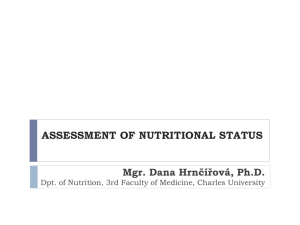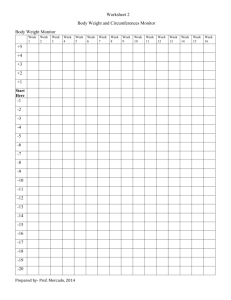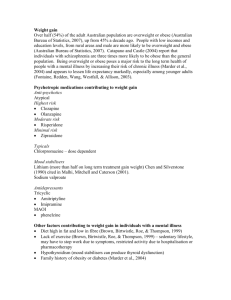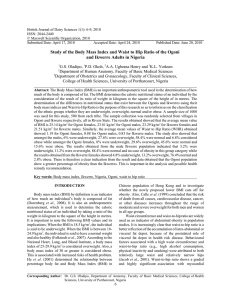Document 13310645
advertisement
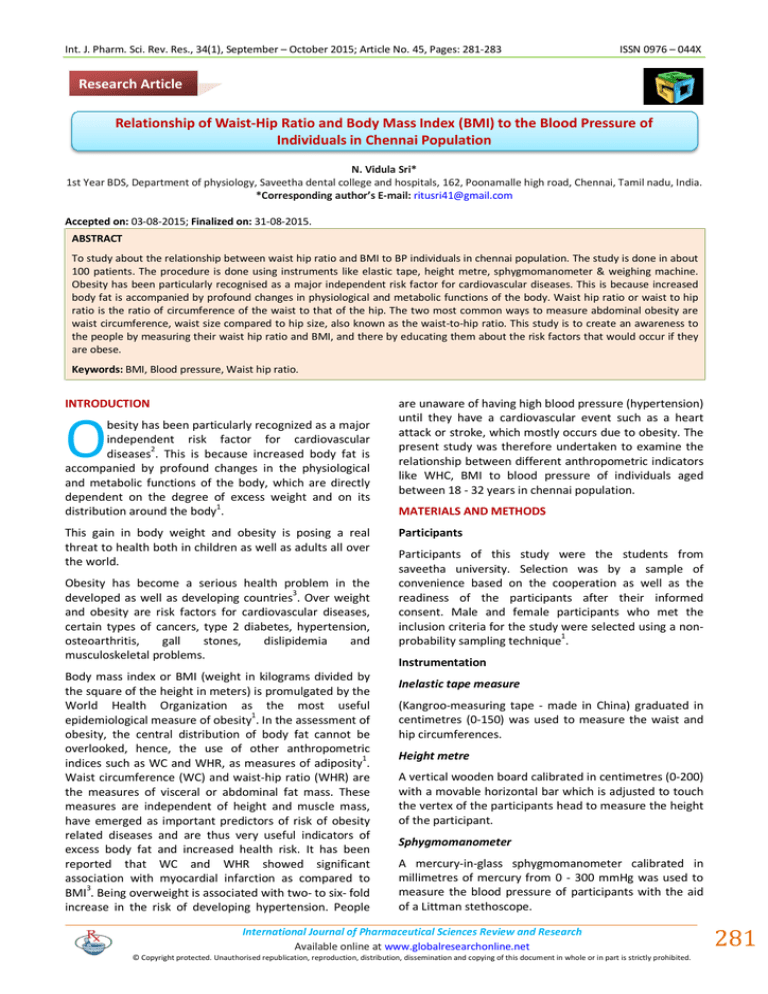
Int. J. Pharm. Sci. Rev. Res., 34(1), September – October 2015; Article No. 45, Pages: 281-283 ISSN 0976 – 044X Research Article Relationship of Waist-Hip Ratio and Body Mass Index (BMI) to the Blood Pressure of Individuals in Chennai Population N. Vidula Sri* 1st Year BDS, Department of physiology, Saveetha dental college and hospitals, 162, Poonamalle high road, Chennai, Tamil nadu, India. *Corresponding author’s E-mail: ritusri41@gmail.com Accepted on: 03-08-2015; Finalized on: 31-08-2015. ABSTRACT To study about the relationship between waist hip ratio and BMI to BP individuals in chennai population. The study is done in about 100 patients. The procedure is done using instruments like elastic tape, height metre, sphygmomanometer & weighing machine. Obesity has been particularly recognised as a major independent risk factor for cardiovascular diseases. This is because increased body fat is accompanied by profound changes in physiological and metabolic functions of the body. Waist hip ratio or waist to hip ratio is the ratio of circumference of the waist to that of the hip. The two most common ways to measure abdominal obesity are waist circumference, waist size compared to hip size, also known as the waist-to-hip ratio. This study is to create an awareness to the people by measuring their waist hip ratio and BMI, and there by educating them about the risk factors that would occur if they are obese. Keywords: BMI, Blood pressure, Waist hip ratio. INTRODUCTION O besity has been particularly recognized as a major independent risk factor for cardiovascular diseases2. This is because increased body fat is accompanied by profound changes in the physiological and metabolic functions of the body, which are directly dependent on the degree of excess weight and on its distribution around the body1. This gain in body weight and obesity is posing a real threat to health both in children as well as adults all over the world. Obesity has become a serious health problem in the developed as well as developing countries3. Over weight and obesity are risk factors for cardiovascular diseases, certain types of cancers, type 2 diabetes, hypertension, osteoarthritis, gall stones, dislipidemia and musculoskeletal problems. Body mass index or BMI (weight in kilograms divided by the square of the height in meters) is promulgated by the World Health Organization as the most useful epidemiological measure of obesity1. In the assessment of obesity, the central distribution of body fat cannot be overlooked, hence, the use of other anthropometric indices such as WC and WHR, as measures of adiposity1. Waist circumference (WC) and waist-hip ratio (WHR) are the measures of visceral or abdominal fat mass. These measures are independent of height and muscle mass, have emerged as important predictors of risk of obesity related diseases and are thus very useful indicators of excess body fat and increased health risk. It has been reported that WC and WHR showed significant association with myocardial infarction as compared to BMI3. Being overweight is associated with two- to six- fold increase in the risk of developing hypertension. People are unaware of having high blood pressure (hypertension) until they have a cardiovascular event such as a heart attack or stroke, which mostly occurs due to obesity. The present study was therefore undertaken to examine the relationship between different anthropometric indicators like WHC, BMI to blood pressure of individuals aged between 18 - 32 years in chennai population. MATERIALS AND METHODS Participants Participants of this study were the students from saveetha university. Selection was by a sample of convenience based on the cooperation as well as the readiness of the participants after their informed consent. Male and female participants who met the inclusion criteria for the study were selected using a nonprobability sampling technique1. Instrumentation Inelastic tape measure (Kangroo-measuring tape - made in China) graduated in centimetres (0-150) was used to measure the waist and hip circumferences. Height metre A vertical wooden board calibrated in centimetres (0-200) with a movable horizontal bar which is adjusted to touch the vertex of the participants head to measure the height of the participant. Sphygmomanometer A mercury-in-glass sphygmomanometer calibrated in millimetres of mercury from 0 - 300 mmHg was used to measure the blood pressure of participants with the aid of a Littman stethoscope. International Journal of Pharmaceutical Sciences Review and Research Available online at www.globalresearchonline.net © Copyright protected. Unauthorised republication, reproduction, distribution, dissemination and copying of this document in whole or in part is strictly prohibited. 281 © Copyright pro Int. J. Pharm. Sci. Rev. Res., 34(1), September – October 2015; Article No. 45, Pages: 281-283 ISSN 0976 – 044X Weighing scale Treatment of data Calibrated from (0-120) kg was used to measure body of the participants. The relation behind the study, including the procedure was explained to the participants. The participants’ weight and height were measured and used to calculate the BMI. Mean and standard deviation were calculated for all parameters, while independent sample t-test was used to compare values for males and females. Pearson correlation was used to find relationship between WHR, BMI, Systolic and diastolic blood pressure. It was considered significant when p-value is less than 0.05 (p<0.05). The waist circumference was measured with a tape measure to within 1 millimetre midway between the lowest rib and the iliac crest, with the participant in the 1 upright position. This was done twice and the average of the two measurements taken as Waist circumference (WC) Hip circumference was measured, with the participant standing erect, feet together and on a horizontal plane. This was also taken twice and average was taken as hip circumference (HC). Waist - hip ratio was measured by dividing the waist circumference by hip circumference. Blood pressure of participants was measured by auscultatory method was done after 5 minutes allowing the participant to remain in sitting position. Participants with systolic pressure above 160 (mm of hg) and diastole above 100 (mm of hg) were considered as hypertensive.1 RESULTS The study population consisted of 100 individuals in which 40 were males and 60 were females with age ranging between 18-30 years. These consisted students from Saveetha University. Table-1 shows the demographic characteristics and indices of adiposity in individuals. From the table it was observed that the mean value of WHR for both male and female participants fell above the range of (0.88) overweight and obese so they 7 were considered obese as classified by . The mean BMI for all participants fell between the healthy range of (2223 kg/m2). No significant difference existed between BMI of male and female individuals. Table 1: Shows the demographic characteristics and indices of adiposity in individuals. All subjects Males Females Calculated t value P-value X±SD X±SD X±SD 21.34±4.33 22.05±4.37 20.87±4.27 1.34 0.182 NS 88.77±11.23 94.90±9.0 84.68±10.75 4.96 0.00 S 85.42±9.04 90.13±7.73 82.28±8.52 4.67 0.00 S 1.03±0.052 1.04±0.047 1.02±0.054 1.93 0.056 NS 22.96±4.14 23.94±2.98 22.30±4.67 1.96 0.052 NS Table 2: Shows the Relationship between indices of adiposity and cardiovascular variables of participants. SBP DBP WC WHR BMI R 0.295 0.263 0.307 P- Value 0.003 0.007 0.002 S R 0.053 0.1 0.85 P- Value 0.6 0.323 0.4 NS WHR- Waist- hip ratio. DBP-Diastolic blood pressure. WC- Waist circumference. BMI- Body mass index. S.D- Standard deviation HC- Hip circumference P-Probability S- Significant SBP- Systolic blood pressure R- Pearson coefficient. NS- Not significant Relationship between indices of adiposity cardiovascular variables of participants. and Table-2 shows the Relationship between indices of adiposity and cardiovascular variables of participants. There was a significant relationship between the systolic blood pressure and the indices of adiposity of individuals X- Mean (p<0.05) but no significant relationship with diastolic blood pressure. DISCUSSION In this study the mean WHR value of for both males and females fell above (0.88) so it was considered as obese. This shows increase in abdominal fat even if BMI falls in a healthy range as previous reports5. This shows that WHR International Journal of Pharmaceutical Sciences Review and Research Available online at www.globalresearchonline.net © Copyright protected. Unauthorised republication, reproduction, distribution, dissemination and copying of this document in whole or in part is strictly prohibited. 282 © Copyright pro Int. J. Pharm. Sci. Rev. Res., 34(1), September – October 2015; Article No. 45, Pages: 281-283 is an universal indicator of risk in a population, it is also a indicator for cardiovascular risk as it is less dependent on body size and height.6 Further the study says that measurement used for obesity in assessment of BMI and WHR is significant with systolic blood pressure and not the diastolic blood pressure. Hip circumference was not independently correlated with blood pressure. 2. Despres J.P., Lemieux I. and Prud’Homme D. Treatment of obesity, need to focus on high risk abdominally obese patients. British Medical Journal, 322, 2001, 716-720. 3. Sukhpal Kaur, Indarjit Walia (2007). Body mass index, waist circumference and waist hip ratio among nursing students. Nursing and Midwifery Research Journal, Vol-3. 4. Dowling, H.J. and Pi-Sunyer, F.X. Race- dependent health risks of upper body obesity. Diabetes, 42, 1993, 537-43. 5. Flier J.S. and Maratos E. (2005) Obesity. In: Kasper, D.L. and Fauci, A.S. (eds) Harrison’s Principles of Internal Medicine 16 ed. New York, McGraw-Hill, 423-40. 6. James, W.P.T. (1996) The epidemiology of obesity: In: Chadwick D.J. and Cardew G. (eds) The Origin and Consequences of Obesity. (Ciba Foundation Symposium 201). Cichester, John Wiley, 1-16. 7. McArdle W.D., Katch F.I., and Katch V.L. (2000) Training the Anaerobic Energy Systems. Essentials of Exercise Physiology 2 ed. Lippincott Williams and Wilkins. CONCLUSION The result of this study says that the individuals with BMI 4 5 (>25kg/m2) and WHR > 0.9 in both males and females are prone to cardiovascular diseases with significant systolic blood pressure. REFERENCES 1. Sanya A.O., Ogwumike O.O., Ige A.P., Ayanniyi O.A. Relationship of Waist-Hip Ratio and Body Mass Index to Blood Pressure of Individuals in Ibadan North Local Government. AJPARS Vol. 1, No. 1, June 2009. ISSN 0976 – 044X Source of Support: Nil, Conflict of Interest: None. International Journal of Pharmaceutical Sciences Review and Research Available online at www.globalresearchonline.net © Copyright protected. Unauthorised republication, reproduction, distribution, dissemination and copying of this document in whole or in part is strictly prohibited. 283 © Copyright pro
